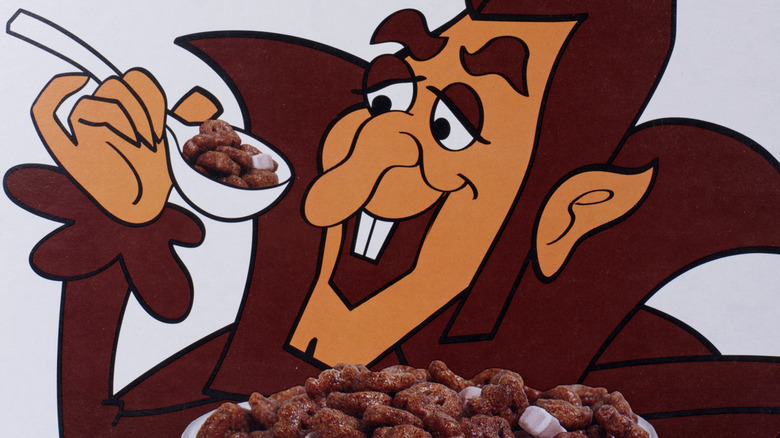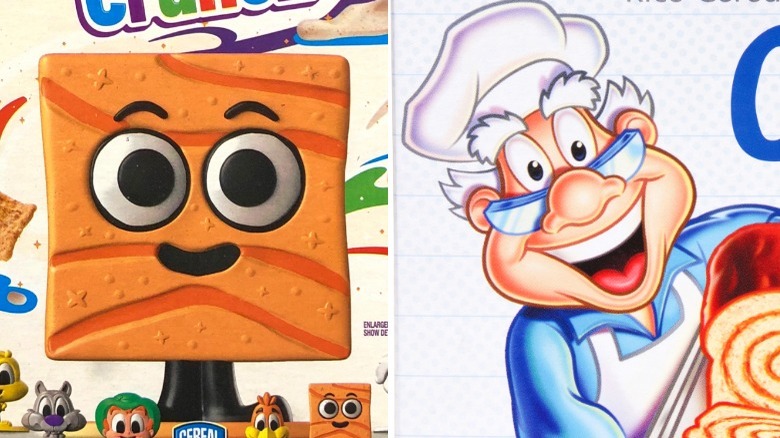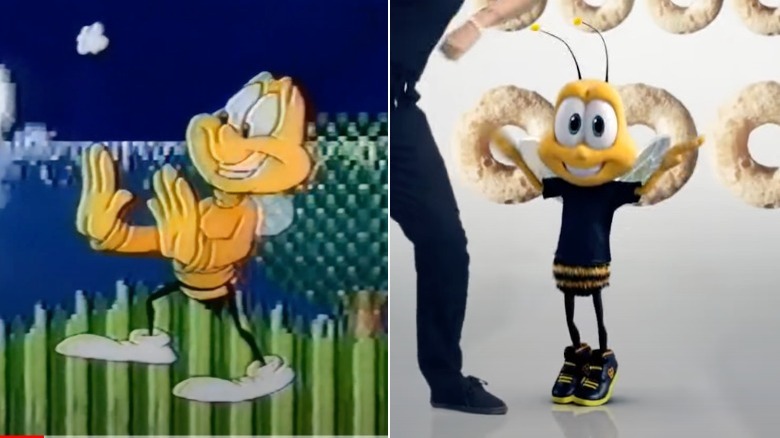11 Cereal Mascots That Were Majorly Rebranded
Cereal mascots like Tony the Tiger, Buzz Bee, and Toucan Sam bring up big feelings. Scroll through their old commercials on Youtube and you're transported to childhood. You'll fall down a black hole, come up for air and realize you've spent hours with Lucky the Leprechaun. You can sing along with jingles, and recite catchphrases. You're still there, slouched over the couch on a Saturday morning with a bowl of cereal precariously perched on a TV tray, arguing with your siblings about what to watch while the Cookie Cop catches the Cookie Crook during the commercial break.
For kids, these characters seem rock solid, always the same and never changing. Then, one day, as a teen, or young adult, a person walks through the cereal aisle and discovers that cheery Chef Wendell has been replaced by cannibalistic cereal squares. Sure, they're funny, but everything about the world is changing and it's not fair! Mascot rebrandings frequently lead to Twitter's equivalent of temper tantrums because people remain emotionally invested in the animations that accompanied them through childhood.
The reaction is understandable, but companies created these loveable characters with an objective in mind: to sell more cereal. When a mascot doesn't tease money out of people's wallets anymore, it's time for a change. One character retires and another is created. Read on for some of the most memorable cereal mascot rebrands in history.
Cinnamon Toast Crunch's Chef Wendell
Cinnamon Toast Crunch is millennial — General Mills began selling it in 1984. Anyone who was a kid and watched Saturday morning cartoons in the '80s or '90s remembers the antics of a certain Chef Wendell during ad breaks. This kind, grandfatherly cook enticed children to indulge in the sugary cereal between 1987 and 2009. Early commercials feature Wendell and his sidekicks singing a jingle about the homemade flavor of Cinnamon Toast Crunch. In later campaigns the character has more eccentric adventures: getting trapped in the TV, shrinking to the size of a cereal square, and stealing Cinnamon Toast Crunch from warehouses.
Chef Wendell wasn't the first character to adorn a box of Cinnamon Toast Crunch, though. In the beginning, it was simply a smiling piece of toast and a grinning cinnamon-sugar shaker tempting children in the cereal aisle. After a mere three years advertisers turned to Chef Wendell. He was far more successful than happy toast, retiring after more than 20 years on the job. The new mascots of choice are anthropomorphic Cinnamon Crunch squares who tend to eat each other whether they're together in a bowl of cereal, on a blind date or just messing around with their phones. There's a lot of licking beforehand. It's hilarious. These characters are aptly named Crazy Squares and are an incredibly effective marketing scheme — this cereal was the third highest-earner of all ready-made breakfast cereals in 2019.
Honey Nut Cheerios's Buzz Bee
Honey Nut Cheerios are a big deal. They bring General Mills around $480 million per year. With those numbers, the cereal's mascot, a humble honey bee, is under a lot of pressure. You likely recognize him, although you may not know his name. No one did for a long time. From his creation in the '80s until 2000, this insect remained nameless. That year, an elementary school student from Texas won the privilege of christening him Buzz Bee.
The marketing team hired top-notch animators and actors to give Buzz life. Thank "Ice Age" animator and "Playboy" cartoonist Dean Yeagle for the inicial design. Aside from changing clothes occasionally and going from 2D to 3D, Buzz Bee's appearance hasn't changed much, but his voice has. At first, actor Arnold Stang put words in his mouth. Later, Billy West — also the voice of Stimpy, Doug, and Fry from "Futurama" — spoke for Buzz. Then, actor Charlie Schlatter took on the job of making the bee's vocal cords buzz when he wasn't voicing Flash in the Lego superhero movies.
Buzz has shared the stage with other greats such as the Adams Family, Garfield, Sonic the Hedgehog, Grumpy Cat, and Nelly. Then, in 2017, Buzz Bee disappeared from cereal boxes, leaving behind a blank space. Fortunately, this lasted briefly to highlight the plight of pollinators. Buzz's back now and so iconic it's hard to imagine the world without him, but who knows how long he'll reign.
Apple Jacks's CinnaMon and Bad Apple
In the 1960s, Apple Jacks cereal's first mascot was Apple Jack. In early commercials, the singing apple encouraged kids to get revenge on bullies, using the power provided by a bowl of cereal. Kellogg's ads end with the apple saying, "Apple Jacks will not be sold to bullies," which makes him seem a little bully-like himself. The campaign worked, though, — in the comments, Joe Weatherford says his mother used to sing the jingle when she gots herself a bowl.
A few forgettable mascots later, Jamaican-accented CinnaMon and Bad Apple came along, racing to bowls of Apple Jacks to see who could make a bigger splash on the flavor. These animations were so successful that they came under fire in 2005 for misrepresenting apples as bad characters and discouraging kids from eating them, but all fame is good fame.
The pair entertained kids in the mid to late 2000s, but it looks like they'll be joining Apple Jack in retirement. In November 2022, animation vlogger, Vailskibum noticed and complained about a redesign of Apple Jacks Boxes. There's still a cinnamon stick and an apple, but they're no longer the snide and happy-go-lucky foods they used to be. The pair blandly smile, and lack any noticeable personality. Fans of the former mascots have lamented the recent change via Twitter and other social media.
Froot Loops's Toucan Sam
Toucan Sam has been representing Froot Loops since 1963. That makes him one of the oldest cereal mascots — but it hasn't saved him from redesigns. In an early Froot Loops commercial, he spoke Pig Latin, which is pretty amazing. He says, "They're crispy and eliscious-day!" Sadly, the toucan hasn't done so for several decades, now. In his more recent ads, he wanders out on exotic adventures around the world and into space. He follows his nose (beak) and finds Froot Loops where ever he goes.
While Toucan Sam's animation has changed to fit the times, advertisers haven't always gotten it right. There was a controversy in May 2020 when Kellogg's put out images of the bird with a tie-die beak instead of a three-stripe beak, huge eyes, and a flat appearance. The backlash on Twitter and other social media was so fierce that #notmytoucan became commonplace. After just a year, the cereal company came up with a new, new toucan who had a much better reception from fans.
Cookie Crisp's Cookie Crook
Cookie Crisp has gone through some amazing mascots over the years — wizard, felon, policeman, bad dog, good dog, and ultimately a wolf.
Cookie Jarvis represented the miniature cookies in the late '70s with actor Lenny Weinrib voicing the character. He also worked on Garfield, the Flinstones, Scooby Doo, and the Adams Family. This wizard's message in the Cookie Crisp commercial was confusing: "You can't have cookies for breakfast, but you can have cookie crisp." It seems like he's saying that cookies are a nutritious breakfast as long as they're small enough to fit in a bowl, although size has no impact on health. The nutrition facts say there's not much difference: a serving of Cookie Crisp (1 cup) contains 12 grams of added sugar while a serving of Chips Ahoy (4 cookies) has 14 grams of added sugar.
Perhaps this confusion led the Cookie Crisp to leave that marketing campaign behind and get more creative. In the 1980s, the Cookie Crook, tried to steal bowls of Cookie Crisp, but the Cookie Cop foiled him at every turn. Some of these commercials were full-on animated shorts with a hero-villain dynamic similar to that of classic Looney Toons.
General Mills eventually phased the cop and robber out. Today, Chip the Wolf has taken their place, but uses some of the Cookie Crook's shenanigans while trying to steal cereal from children. They outwit him at every turn.
Honey Smacks's Smacking Brothers
Dig 'Em Frog of Honey Smacks may be the only amphibian to appear on a box of cereal, but that's not his only claim to fame. He's also one of the few mascots to be given a pink slip and get called back just months later.
From their inception in 1953, Honey Smacks (or Sugar Smacks as Kellogg's called it in the early days) had an identity problem when it came to mascots. At first, they were clowns. Then, Kellogg's replaced them with Smaxey the Seal — cute and completely forgettable. Later, the Smacking Brothers came along. The name says it all — these siblings smacked each other in commercials until their mother told them to get Sugar Smacks instead of pillows and boxing gloves. They were funny, but it's easy to see why these ads went out of favor — most parents don't want kids hitting each other even if it is just a cartoon.
In 1972, Dig 'Em Frog showed up to save the day. Far more charismatic than the previous mascots, he looked good in commercials and on the box. He stayed there until Wally the Bear showed up to take over in 1986. A bit of chaos ensued — some college students protested for a day, asking that Dig 'Em Frog come back. Kellogg's paid attention and brought the long-legged mascot back in 1987 and left him on the box for good.
Corn Pops's Poppy the Porcupine
Having a recognizable mascot is hugely beneficial. It engages consumers and converts a product into a household name. Advertisers use test groups, but ultimately mascots are hit or miss. Some cereals have had tremendous luck: Trix with their rabbit and Rice Crispies with Snap, Crackle, and Pop. Corn Pops, on the other hand, has not come up with an instantly identifiable mascot in its 70 years on the shelves, but they tried.
Long ago, there was Sugar Pops Pete, a gun-happy prairie dog. Later, the Big Yellow Cowboy bargained with kids trying to exchange big yellow objects for bowls of Corn Pops. The kids always kept their cereal, though. Poppy the Porcupine was another mascot. His popping suitcase came with corn pops on the inside. None of these characters stood up to the test of time, though.
More recently, Corn Pops turned to fingers holding real corn pops with sketched-on faces. The voiceovers sing and talk about a cinnamon version of the cereal. Not exactly mascots, but close. When anthropomorphic cereal grains showed up on the back of the box in 2017, author Saladin Ahmed pointed out racial insensitivity — all of the yellow Corn Pops are at the mall having fun, but the only brown Corn Pop is dressed as a janitor, cleaning the floor. Kellogg's quickly apologized and changed the artwork, but the box still lacks a mascot.
Cocoa Puffs's Sonny the Cuckoo
In order to have the mascots people love, other mascots have had to die. This is the case with Cocoa Puffs, too. When the cereal first came out, the Cocoa Puff kids adorned the box, but they didn't last for long. That's when General Mills came up with a cuckoo bird that was "Cuckoo for Cocoa Puffs."He's called Sonny the Cuckoo because he appeared along Gramps in early commercials, but his sidekick joined the Cocoa Puff Kids after a few years.
The early versions of this bird wore a pin stripe jacket and bow tie. In fact, the biggest changes in this mascot have been what he's wearing. At some point, he exchanged his coat for a striped turtle-neck sweater. In the 2000s, he put on a bathing suit so he could go surfing and, then, skating gear. By 2010, he'd lost most of his clothes and donned only a tie and glasses. Today, he's unclothed, but fortunately covered in feathers and he still uses the same catchphrase. It's nice to know that some things never change.
Lucky Charms's Lucky the Leprechaun
Lucky Charms is just shy of turning 60 and Lucky the Leprechaun has been its mascot almost from the start. His appearance has changed a bit — he no longer has pointy ears and he used to wear a plaid jacket. Even the idea of his commercials is the same: Kids want to catch a leprechaun and get his box of Lucky Charms. There was a time, though, when General Mills considered replacing him.
Artist Alan Snedeker was working with General Mills around 1975. He'd previously created Waldo the Wizard for another cereal that didn't pan out. They decided to try the character out on Lucky Charms boxes. Both mascots existed simultaneously — they tested Waldo on the East Coast and Lucky stayed on boxes throughout the rest of the United States. Snedeker says that Lucky only survived because he made him nicer.
Today, it's hard to imagine Lucky Charms without the leprechaun so, General Mills probably made the right decision.
Honey Comb's Bernard the Bee Boy and Craver
Internet conspiracy theories surround everything, even a Honeycomb cereal mascot. Millennials may remember the furry, twitchy, Craver, who was the personification of hunger. On screen, kids would be at school, camping, skateboarding, or hanging out in the kitchen when their desire for Honeycomb cereal would overtake them and they'd turn into chaotic little monsters. Anyone who's dealt with a hungry, grumpy kid gets it.
The conspiracy theory is this: Vlogger, Doplex, says that Post Cereal doesn't want us to remember the Craver. Information about the creature is suspiciously difficult to find despite his campaign lasting around 10 years. The cereal's official website mentions other ads including the 1960s animated cowboy, Honeycomb Kid, and the 1970s Honeycomb Hideout. The Craver doesn't show up in the official story of the cereal and the company sent Doplex an email saying information pertaining to the mascot was lost when ownership changed. Perhaps, the craver simply failed to capture the public's imagination the way Tony Tiger or Buzz Bee did or maybe something more sinister is afoot.
Of course, the official website doesn't mention Bernard the Bee Boy either. In mockumentary-style ads for Honeycomb, a Jane Goodall-esque woman explains that bees raised him. He buzzes, crouches, and moves his eyes sporadically. More importantly, he'll only eat Honeycomb. Funny, but possibly embarrassing to Post. As of the date of this article's publication, Honeycomb is without a mascot which could mean a new, lovable character is just around the corner.
Monster Mash's quintet
Ever heard of Count Chocula, Franken Berry, Boo Berry, Frute Brute, or Yummy Mummy? These five monster cereals have come and gone and then come back seasonally and then gone again. That describes the design of the mascots as well — they showed up with their original design, went through revamps, and then went back to their retro versions.
The five monster movie mascots are precisely what make these cereals so popular. They've also captured the imagination of popular artists like Quentin Tarantino, KAWS, Karlee Morse, Dave Johnson, Jim Lee, and Terry and Rachel Dodson. That's a lot of star power for a cereal that only shows up on store shelves around Halloween (some years).
Originally, General Mills designed and sold each of these cereals on their own. In 1971, it was Count Chocula — designed by George Karn, creator of the Trix Bunny — and Franken Berry. A year later, Boo Berry, joined their ranks. Then, Frute Brute came along but was discontinued after six years. Yummy Mummy showed up on shelves in the late '80s and early '90s. And 2013 was the first time General Mills sold all five monster cereals together as a marketing gimmick. The culmination of this was Monster Mash, a mixed cereal containing all five varieties, sold in 2021.











